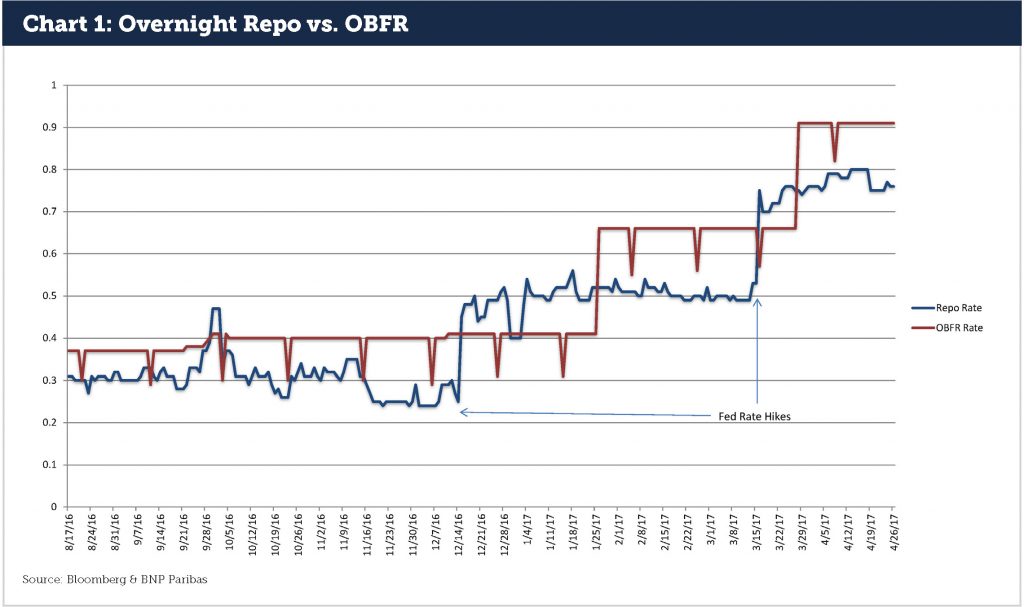A combination of legislative reform, geopolitical events and uncertainty as to the pace of US monetary policy tightening has created a disconnect in the financial markets, creating substantial opportunities for well-placed investors. Accordingly, securities lending participants would be well-served to reevaluate their risk tolerance in order to take advantage of current conditions with their noncash and cash-collateral reinvestment strategies. A guest post from BNP Paribas.
Beneficial owners have understandably maintained a more risk-averse posture in the wake of the 2008 financial crisis, which witnessed losses attributed to cash collateral reinvestment. At the time, a strategic shift toward intrinsic-based lending, with a focus on indemnified reinvestment products, was considered a prudent approach for beneficial owners who committed to participating in securities lending. As this risk aversion subsides, however, sophisticated participants are increasingly shifting from intrinsic-only lending and conservative reinvestment strategies to increased credit and duration exposures as a means of capturing greater yields.
While the exact timing and frequency of the Federal Reserve’s rate-tightening regimen—which, at present, includes possibly two more hikes this year and a total of three or four additional hikes in 2018—has yet to be determined, what is certain is that the market is already pricing in higher rates over the next couple of years. Within this context, beneficial owners can certainly capitalize on the market opportunities by increasing their exposure to credit sensitive instruments in the cash collateral market.
A Shift in Strategy
To date, a majority of securities lending portfolios have adopted an overnight-only lending strategy combined with cash collateral investments limited to government money market funds or US Treasury collateralized reverse repurchase agreements. However, a trend is emerging among beneficial owners to broaden their risk profile in an effort to capture incremental yield. This shift is predominantly driven by depressed yields on these reinvestment products.
The Overnight Bank Funding Rate (OBFR) has become the securities-finance industry’s main benchmark for pricing rebate rates on loans, as well as a proxy for the risk-free rate. A majority of lenders will loan securities at a rate linked to OBFR, usually at a spread of 5 to 10 basis points below the daily published rate, which currently stands at 0.91%. Assuming a financing rate of around 0.81% (OBFR less 10 bps), reinvestment yields of a portfolio would need to surpass 0.81% to maintain a positive spread. With government money funds yielding approximately 0.60% and UST collateralized repurchase agreements hovering around 0.75%, the opportunity to lend securities linked to OBFR at a rate of less 10 basis points are limited at best. Chart 1 illustrates the current conundrum.
 Sources: Bloomberg, BNP Paribas
Sources: Bloomberg, BNP Paribas
Despite the negative spread between OBFR and traditional risk-free reinvestment products such as government money market funds and UST reverse repurchase agreements, investors can nonetheless achieve higher returns by allocating a portion of their cash collateral to prime money market funds or short term bond funds, as well as through adopting a broader collateral schedule for their reverse repurchase agreements.
The implementation of the SEC’s Money Market Reform in October 2016, and the subsequent shift of nearly $1 trillion of assets from prime funds to a stable NAV of government funds, has created a nearly 40 basis-point spread between these two types of funds. In addition, spreads of assets owned by prime funds have also widened. Yields on traditional money market products, such as commercial paper, certificates of deposits, corporate bonds and even asset-backed securities, have widened, presenting opportunities for those with a higher risk tolerance. As an example, these short-dated instruments offer yields of 1.25%, presenting ample spread between the OBFR funding rate of 0.91%, for limited risk.
Of course, such changes in strategy can lead to heightened market liquidity risk, interest rate risk as well as duration risk. However, all of these can be mitigated using fairly straightforward portfolio risk-management techniques, such as limiting the weighted average maturity of the portfolio as well as implementing a duration-matched lending program. Applying minimum levels of overnight liquidity to a portfolio as well as concentration limits on an issuer or asset class basis may also help reduce portfolio risk.
Finding an agent capable of properly managing a credit-sensitive portfolio is paramount for institutional investors. For those with in-house capabilities, the option also exists to self-manage cash collateral in order to maximize the portfolio’s total investment return.
Opportunities to monetize current market spreads are not only limited to cash collateral reinvestment strategies. Participants engaged in a non-cash collateral program also have the ability to substantially increase their returns through the expansion of their permissible collateral and extending the tenor of their loans. Equivalent opportunities exist for lending participants to increase their program’s yield through the acceptance of non-traditional repurchase agreement assets, such as high yield bonds, equites and even securitized assets. Several lending agents are willing to indemnify these transactions with customized haircuts and tenors to offer substantial increases in interest rate spread.
According to a representative of a large insurance company, “Our participation in a securities lending program is designed to maximize our return while adhering to the risk tolerance of our institution. The ability to monetize market opportunities through the expansion of our permissible collateral and engage in longer tenor transactions while maintaining ample levels of liquidity under a fully indemnified program is prudent and in the best interest of our shareholders.”
Whether you opt to participate in the growing trend of adding credit exposure to your cash collateral portfolio, or expanding the scope of your indemnified collateral schedule outside of government debt, guidelines should be implemented which adhere to your institution’s risk profile.
One solution to capturing current market opportunities through an allocation of credit sensitive instruments, while adhering to your unique risk profile, would include implementing a hybrid approach to your collateral strategy. This is similar to the analogy of a checking or savings account where the checking account is your government money market fund or overnight US Treasury collateralized repurchase agreement, while your savings account allocation is the equivalent of your credit sensitive portfolio with longer tenors and credit sensitive instruments. A combination of both strategies is considered prudent while adding potentially significant returns.
Ensuring Proper Portfolio Protections
Despite the opportunity to boost incremental securities-lending returns through broader collateral guidelines and credit-sensitive instruments, any changes to existing portfolio strategy should be discussed with your lending agent to ensure the appropriateness of these portfolio management approaches. Using proper risk controls to determine an acceptable allocation between your “checking and savings accounts” is prudent, as is defining concentration limits, liquidity parameters, collateral liquidation, interest rate mismatch and indemnification policies. Taking these steps, while also adopting a customized, tailored approach to program management, can in turn lead to substantial value for the beneficial owner.
 Michael Saunders is Head of Investments & Trading, Securities Lending North America at BNP Paribas. In this capacity, Mr. Saunders is responsible for managing client lending and cash collateral reinvestment porQolios with a focus on risk management. Mr. Saunders is also a member of the securities lending group’s Investment Committee and Product Management Committee.
Michael Saunders is Head of Investments & Trading, Securities Lending North America at BNP Paribas. In this capacity, Mr. Saunders is responsible for managing client lending and cash collateral reinvestment porQolios with a focus on risk management. Mr. Saunders is also a member of the securities lending group’s Investment Committee and Product Management Committee.
Mr. Saunders has extensive knowledge of investment grade, short-duration investment products which assist in the construction of client portfolios consisting of 2a-7 like assets including corporate bonds, asset-backed commercial paper, securitized products and other liquid assets. His professional experience also covers the trading and portfolio management of products including all money market eligible securities as well as commodities, options and financial futures.
Prior to joining BNP Paribas in 2013, Mr. Saunders spent two years at ClearLend, a division of Wells Fargo Bank, NA, as a Cash Collateral Portfolio Manager, in which he was responsible for managing client investment portfolios exceeding $18 billion, as well as implementing investment guidelines, identifying opportunities within the market and relaying current dynamics to their client base.

